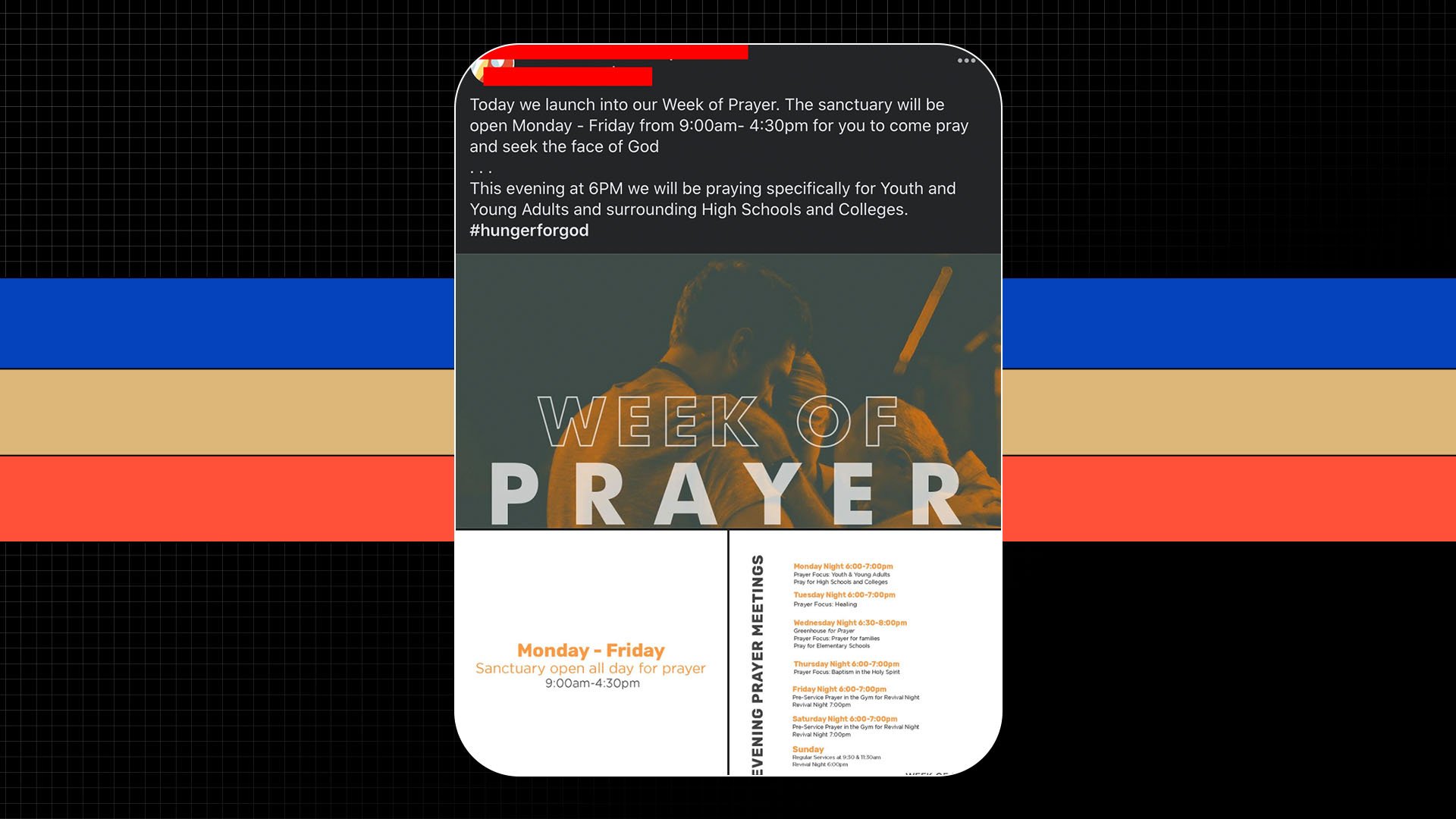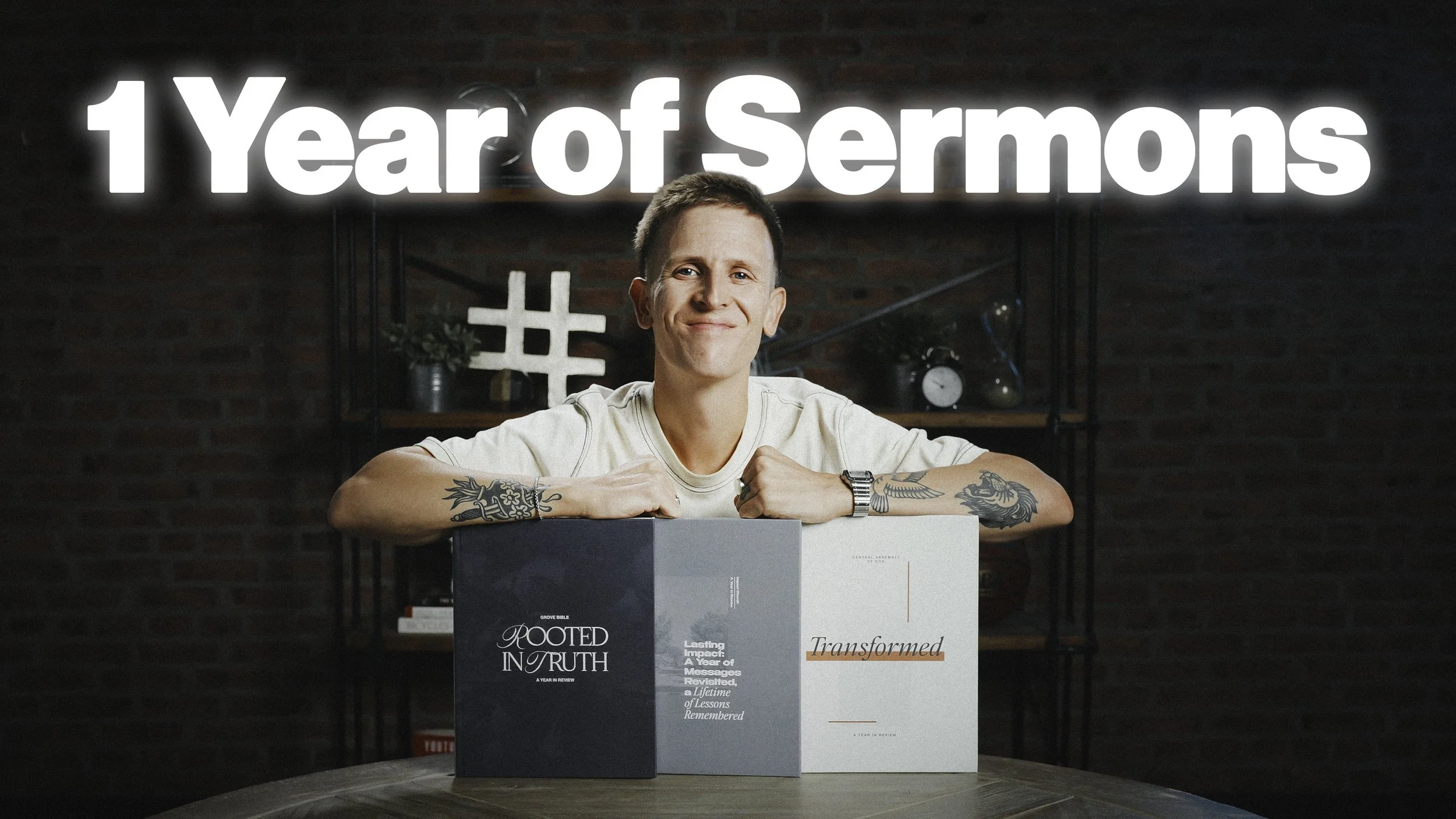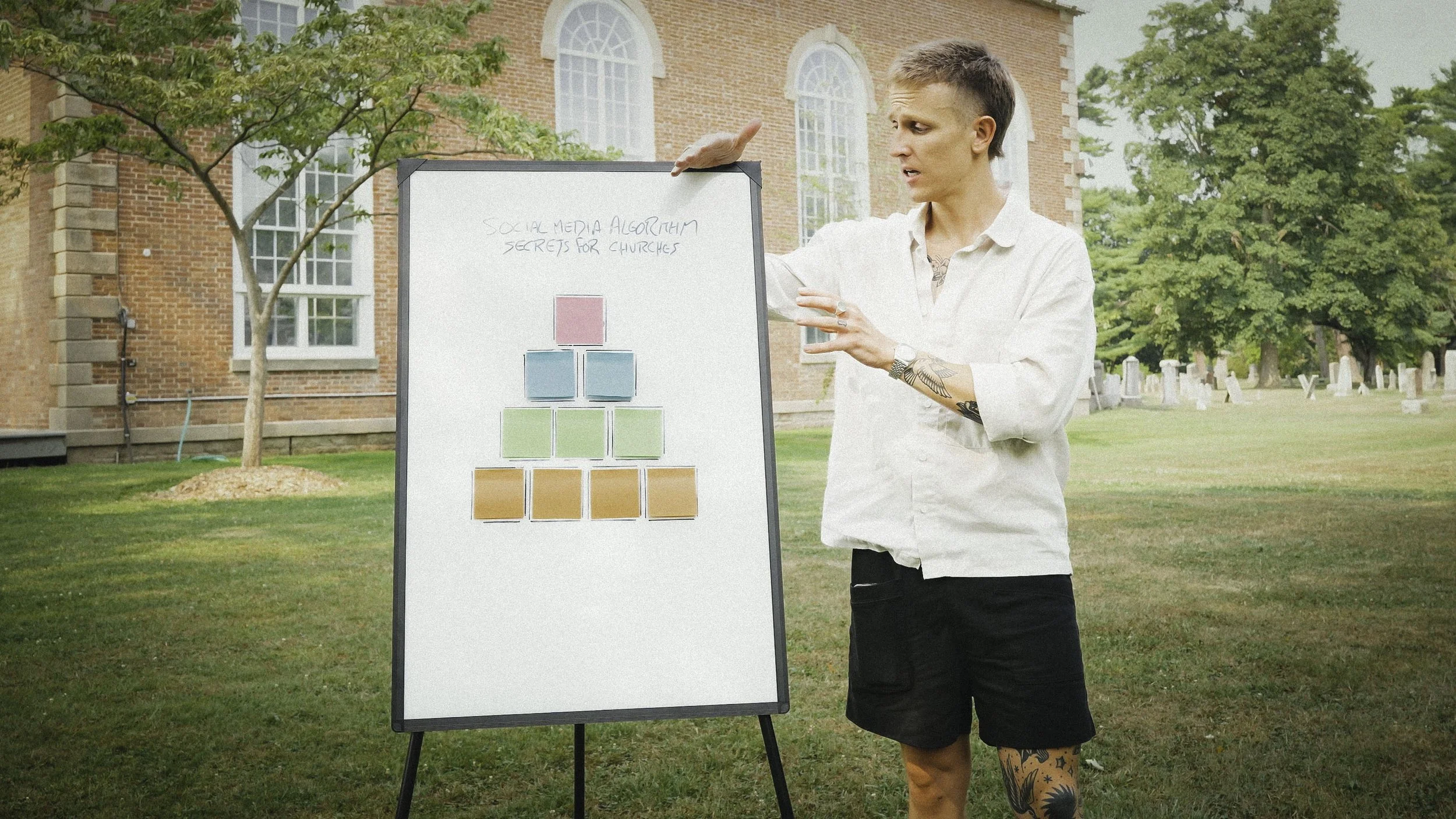Church Social Media Policy: 10 Essential Rules
Welcome to the complete guide to social media policy and strategy for churches.
Below are 10 essential rules I've developed from working directly with hundreds of churches 1-on-1.
If you're new to helping your church with social media, this is for you.
If you've been at it for a while, this is also for you.
So let's get started.
Free Bonus
Click below to download the Church Social Media Policy PDF – share it with leadership and get everyone on the same page.
Download Church Social Media Policy

Rule #1: Our efforts on social media must be informed by Christ
First and foremost, our efforts on social must be informed by Christ.
We must ask:
Why be on social media as a church?
It’s about embracing The Great Commission and taking The Good News to where the people are.
In the scope of human history, we have never seen anything like social media in terms of attention and scale.(1)
Across all groups, including age, race, gender, income, education, urban, rural, and suburban, most US adults use social media daily.
It gets better, though! Because something as powerful as social media must have a high entry cost, right? This can't be accessible to the average church?
Wrong. It is free.
Of course, now, we have to confront a follow-up question:
How should churches use social media?
Again, let’s look to Scripture.
Because here’s what I see - when Jesus spoke, he often used ideas accessible to the average person as entry points to talk about the Kingdom of God.
A few examples are:
Agriculture | Matthew 13
Farming | Matthew 21
Baking | Matthew 13
Economics | Matthew 25
Labor | Matthew 20
Wine | Matthew 19
Sheep | Matthew 18
The idea here is simple:
Find the intersections between faith and culture.
Where can The Good News cross paths with the lived experiences of the person you’re trying to reach?
Rule #2: Use social media to *do* ministry – not just *promote* ministry
Use social media to DO ministry – not just promote ministry.
What does this mean for you?
Let’s look at two examples.
Example #1.
We have a church using social media to promote an upcoming in-person prayer event they’re hosting.
And this is a prototypical example of how most churches use social media.
But instead of inviting people in your church to pray soon, why not ask them now?
Like in this post from Legacy Church - 3 Biblical Declarations To Pray Over Your Marriage.
Example #2.
Here, we find a guided prayer rooted in Scripture so people know exactly what to say.
And just look at this post's traction: 35,000+ likes and close to 800,000 views.
Churches like Legacy Church are doing a great job using social to DO ministry and not just promote ministry.
Check out more from Legacy Church by listening to our podcast with their social media director and production director on The Pro Church Tools Show.
Rule #3: #NoWeeksOff
Every church affecting life change online is different, but they all have one thing in common…
They consistently make great content for their community.
Social media is a long game. And there’s really only one key to success.
Ready for it?
Post content that is valuable to your church for the next ten years.
Why ten years? Because ten years is a very long time! And that’s what relationships demand - years and years of meaningful investment.
You don't need daily posts, but a regular, weekly presence is vital.
And what might come from that?
Consider Mosaic Church.
This church plant has grown 5X over the past few years, with 60% of its new visitors coming from social media.
They posted consistently.
3-5 times per week for years with minimal traction on social, until finally, boom. This is what #NoWeeksOff can translate to when you keep showing up.
And this is in a country where this church can't even put their address publicly on their website because it's against the law for a Christian church to do that.
This just again shows the power of social media.
If you want to hear more of Mosaic's story, we did a podcast with their lead pastor.
Free Bonus
Click below to download the Church Social Media Policy PDF – share it with leadership and get everyone on the same page.
Download Church Social Media Policy

Rule #4: Reach Wide, Connect Deep
Below are analytics screenshots from churches we're working with at SocialSermons.com.
This is what it looks like when you have a post that reaches a broad audience on social.
The white part of the ring shows non-followers.
The blue part (which on this ring is practically impercivably blue) is followers.
So, as you can see here, the post reached close to 13,000 total accounts, and only 73 of those were the church's existing followers.
Our other two examples have similar ratios.
All three of these are typically small to mid-size churches.
And so this is what it looks like when a post reaches wide.
But we also want to connect deep.
We want social media to invite people to take their next step.
This is why it’s essential to include an end screen inviting people to get connected with the church at the end of every sermon on social media.
Calls to action like:
Like & Follow for more
Listen to the entire sermon via podcast or on YouTube
What do these invitations translate to?
Glad you asked. This brings us to…
Rule #5: Social media is a springboard for discipleship
It’s not just about views and likes but the actual next steps taken because of a social media post.
Consider this testimony a pastor shared with me.
This is a DM the pastor received:
"I was scrolling through FB and came across a clip of your sermon from yesterday that grabbed my attention. On my lunch break, I listened to your entire sermon. It convicted me and challenged me. I've been hot and cold in my walk with Jesus. To be honest, I've never fully committed to him. But I know what I have to do now and also understand that my repentance has to bear fruit."
So, let's track this journey…
>>> This person watches the sermon clip on Facebook after it grabs their attention
>>> An invitation at the end of that social sermon is made to watch the entire message
>>> This person dedicates their lunch hour to doing that
>>> This leads them to recommit their life to Christ and contact a pastor for pastoral care.
This is social as a springboard for discipleship.
But none of that could have happened if this church missed one crucial step.
And that's rule number six.
Rule #6: Stop the Scroll
Recall what the person in the screenshot from above said at the beginning of their testimony…
"I was scrolling through FB and came across a clip of your sermon yesterday that grabbed my attention."
GRABBED MY ATTENTION.
The prerequisite to life change, discipleship, and people hearing The Good News is attention.
It's the most valuable commodity we can possess as churches because, without it, it doesn't matter how great our message is because no one will hear it.
So here’s what you can do:
After you've identified a portion of the sermon that would make sense for social, you write a hook and put it on the center of the screen for the first 3 seconds of the video.
This is what stops the scroll.
It's the promise we make to the viewer.
If you give us your time and attention, here's what you'll get in return.
Attention must be earned, and the hook is how we do that.
Rule #7: Offline and online ministry must work together as allies, not adversaries
Now, I haven’t addressed this at all yet – I’ve saved it until now. But, there will be people who read this post who think to themselves:
“Social cannot replace in-person gatherings.”
To which I would say, “Correct. I fully agree with you.” But here’s what I’ll also say:
“What we do in person can never replace what we do online.”
And listen, you might shy away from that idea at first. So allow me to explain further. Your week has 168 hours. For most churches, roughly one of those hours is dedicated to an in-person service. But that still leaves 167 hours where you won’t meet in person with your church.
(that also assumes your entire congregation attends service every week – which is unlikely.)
But…you can still connect with them online.
And this is why online and offline ministries need to work together. The mission of our churches is to affect life change. And both offline and online ministries play a unique role in making that happen.
Going back to Rule #5 - Social media as a springboard for discipleship - I'm not suggesting that discipleship occurs entirely or even primarily through digital platforms.
Not at all.
That happens best through in-person relationships and the proximity that can only occur face-to-face. But social media can be the springboard for that, in the way it was for that person in the DM.
Here's another example from a case study with a church we're working with at SocialSermons.
Here's what the lead pastor said to me:
"I was picking up a grocery order at the supermarket. And a guy comes up to me and says, ‘Are you a pastor?’ And when I said yes, he responded, ‘You showed up on my TikTok feed. My wife and I are looking for a church and we're gonna be checking yours out.’”
You can click here see the complete case study, but again, this is a perfect example of online and in-person ministries working together.
That's the goal.
Rule #8: Repeat the best, forget the rest, and continue to test
Here’s a social media secret you won’t hear very often:
Nobody knows what they’re doing.
Talk to anyone you look up to online, and they’ll tell you about all the times they posted content they were super excited about – only to see it fall flat.
Inversely, they’ll tell you some of their most popular posts were pieces they thought were sub-par, and they never could have envisioned them taking off the way they did.
So, when you stumble upon a post type that resonates with your audience, use it.
Again.
And again.
And again!
And keep pulling from that well until it runs dry.
Here's a great example of that - One Church. We also did a podcast with them on The Pro Church Tools Show.
Their first viral post was from a sermon clip on parenting.
Again, there's that intersection of faith and culture, right? When One Church noticed this kind of post did well for them, they returned to it repeatedly. Their TikTok account now has a quarter million followers. Their Instagram has close to one hundred thousand.
Their church is about a decade old. They started with 90 people. They're at 1,800 now.
When you see a post that's working, repeat it.
Legacy Church did the same thing with their bold declarations list post.
Remember this one:
They did another one - 3 declarations to pray over your finances.
And another one - 3 declarations to pray over your children.
And guess what? Those posts popped off, too!
Repeat the best, forget the rest, and continue to test.
That last stanza is really important. You'll want to reserve some creative energy and space on your social media calendar to try new stuff.
Because you never know what kind of post might resonate with your audience. There was a time when Legacy Church had never published one of those list post Reels.
They never would have stumbled upon it if they hadn't continued testing.
Rule #9: All it takes is one video
All it takes is one video.
Here's a post from a church we're working with at SocialSermons.
A few weeks before this, they emailed me saying,
"Brady, when is it going to happen for us, we've been following all the best practices, we've been doing what you're saying, but it's not clicking yet."
And then shortly after - boom. More than ten million views. More than 75,000 shares. Their Facebook page grew by 407%.
You can read the entire case study of this church by clicking here.
But this is how online is different from being in person. Because, sure, we have services in person where more people come than on a typical Sunday, right?
Often, that's Easter or Christmas. But what happens the week after that? Very few, if any, return.
Online is different.
If you follow the #NoWeeksOff approach and implement the principles in this policy, you WILL have a post that reaches a wide audience.
And because we're inviting those people to connect deeper with your church, a subset of that audience will follow your church's account, meaning the next time you post, you'll have more attention than you did before.
With every big post, you set a new baseline for your church online.
And it becomes this positive cycle.
How does it start? All it takes is one video.
Just stick with it.
Rule #10: The Church Advantage
Listen up; I know serving in a church is not easy.
We don't have the resources, time, experience, or budget businesses do.
But, our churches do have something that does not exist across virtually any other industry, which is a massive advantage for us.
What is it?
Churches are one of the only organizations in the world with senior leaders who already create and share a message every single week.
And thanks in part to the pandemic, most of our churches now have video recordings of those sermons if we didn't before.
Which means we are all sitting on goldmines of content for social media.
Imagine you were a real estate agency, law firm, or dentist’s office - you’d need to plan and create for social media above and beyond everything else you already do.
But as churches, we can simply rely on our centuries-old tradition of preaching The Good News from the pulpit - and then bring that creative and spiritual work that has already been done to social media.
In effect, we, as churches, get to skip the first step of social media, where we have to come up with ideas.
The ideation process is already baked into the weekly rhythms of the church!
SocialSermons
If you want to work with me directly, you can go to SocialSermons.com.
This is where we do all the work for your church on social. You don't have to lift a finger.
Because this work is all custom, we only have space for about 150 churches. We sold out every spot in the first week we launched this service. But you can join the waiting list on SocialSermons.com.
That being said, if you see the 'Book A Call' option on the site, if you can click that, that likely means we have a few spots available. We try to keep 2-3 spots open as much as possible.
If you think you'd be a good fit, you can book a call with me directly, and we can see if we're a good match for each other.
Conclusion
Implementing these rules can significantly enhance your church's social media impact.
Remember, both offline and online ministries are crucial for life change. Let's use every tool at our disposal to spread The Good News!
Free Bonus
Click below to download the Church Social Media Policy PDF – share it with leadership and get everyone on the same page.
Download Church Social Media Policy



















